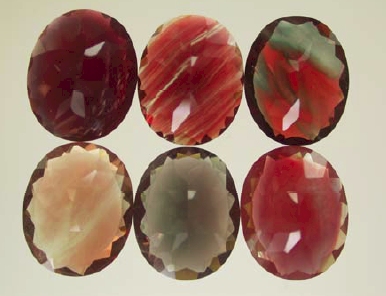The Chinese red feldspar controversy:
Chronology of research through July 2009
George R. Rossman
Division of Geological
and Planetary Sciences
California
Institute of Technology, Pasadena, CA.
ABSTRACT
Red copper-containing plagioclase feldspar from Oregon has been available
for over a century. In the early 2000s, new localities for copper-bearing feldspar
were reported from the Democratic Republic of the
Congo and from Tibet
or an unspecified locality in China.
The new material has been the subject of widespread concerns about its
geographic origin and natural color. In fact, extensive studies of its
composition, spectroscopy, physical appearance, and isotopic properties suggest
that much of the red andesine on the market is the product of laboratory
diffusion of copper into pale yellow andesine from Inner
Mongolia. All samples initially subjected to testing as part of
this study gave strong evidence or suggestions of treatment. Traces of copper-containing fluxes
found on rough stones, and measurements of argon isotopic composition in
particular, demonstrate that the tested material was recently heated to high
temperatures under conditions where copper diffusion could occur. These results
apply to samples that were obtained up to and including July 2009, but do not
include samples from expeditions to Tibet in 2010.

A variety of faceted andesines in table-down orientation
Last upgraded 8-Aug-2011

